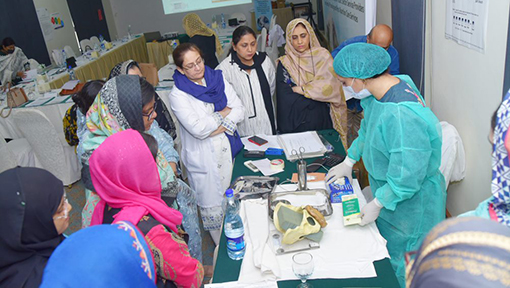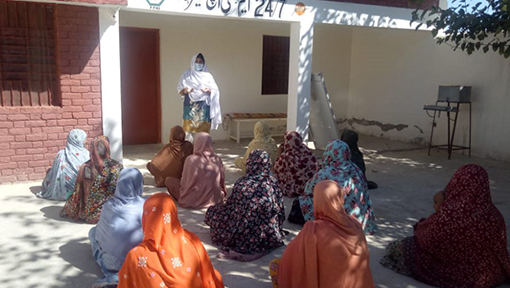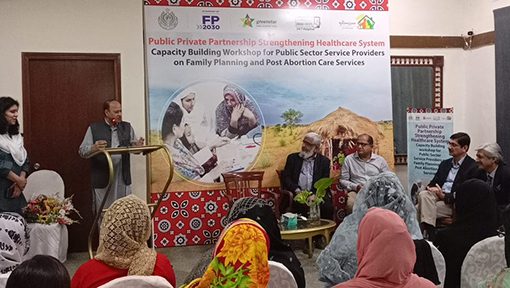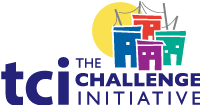Pakistan: Demand Generation
- Home
- Help and Support
- Close
- Toolkits
- Global Toolkit
- AYSRH Toolkit
- Hub Toolkits
- Core High-Impact Practices
- Gender Essentials Mini Course
- Close
- Resource Collection
- Community of Practice
- Coaching
- Log In/Register
- My Profile
- English
Community Health Workers
What Is It?
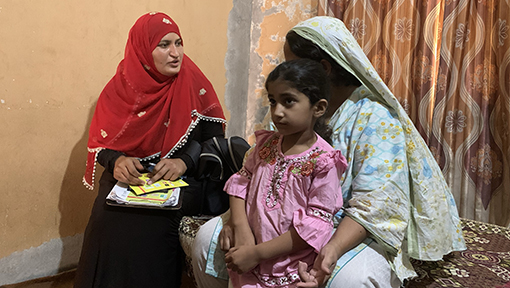 Pakistan started a National Program for Family Planning, commonly known as the “Lady Health Workers Programme” in 1994. In Pakistan, there are two branches of Community Health Workers – Lady Health Workers (LHWs) and Family Welfare Assistants (FWAs), as explained below.
Pakistan started a National Program for Family Planning, commonly known as the “Lady Health Workers Programme” in 1994. In Pakistan, there are two branches of Community Health Workers – Lady Health Workers (LHWs) and Family Welfare Assistants (FWAs), as explained below.
These Lady Health Workers (LHWs) are paid workers by Department of Health and are responsible for creating awareness and accessibility to primary healthcare centers run by Lady Health Visitors (LHVs) for basic medical necessities. Each LHW is responsible for providing healthcare education to 1,000-1,500 people in her community.
LHWs conduct door-to-door visits to create demand generation about maternal, newborn and child health (MNCH), including family planning, and are primarily responsible for conducting health education and promotion in their communities. They make referrals to the health center run by LHVs and other healthcare centers. These LHWs provide one-on-one counseling about family planning and child birth and are allowed to provide non-invasive family planning commodities, such as condoms and pills.
LHWs also receive training in gender-responsive counseling and service provision.
Family Welfare Assistants (FWAs) play a similar role to the LHWs but they are overseen by the Population Welfare Department (PWD). FWAs provide one-on-one counselling to married women of reproductive age (MWRAs), generate demand for child birth spacing and family planning in the community, and provide referrals to Family Welfare Workers (FWWs) that are equivalent to LHVs.
Responsibilities of a Lady Health Worker/Family Welfare Assistants:
- Mapping the areas of services
- Registering MWRAs
- Providing family planning counseling
- Generating demand in their communities
- Conducting household visits
- Conducting neighborhood meetings
- Creating linkages between clients and LHVs/Basic Health Units (BHUs)/Family Welfare Centers (FWCs)/Family Health Centers (FHCs)
- Providing short-term methods, such as condoms and pills, to MWRAs in need
- Supporting vaccination drives, including polio, in their communities
What are the benefits?
- CHWs are very well-trusted members of their communities and can provide an opening into the communities’ health needs, including unmet need for family planning.
- They are trained in their field and generally appointed by the Ministry of Health and Population Welfare Departments of their respective districts and tehsils.
- They can build linkages and referrals in the communities, which can decrease waiting times and mitigate inaccessibility issues for women in need of family planning methods beyond their scope.
- As they conduct door-to-door visits, they can also manage follow-ups for infection prevention and quality of care.
- Because they are well-trusted and respected in the community, LHWs and FWAs are also part of various vertical programs conducted by the Government of Pakistan.
How to implement
As stated above, the Government of Pakistan has various robust programs executed by the Department of Health (LHWs) and Population Welfare Departments (FWAs). Despite over 110,000 CHWs, healthcare workers still need to address the unmet need for family planning in Pakistan and expand these outreach programs.
Step 1: Identify Existing CHWs Who Can Provide Family Planning Information and Services
In Pakistan, the Ministry of Health works with over 110,000 Lady Health Workers on various other vertical initiatives, including polio vaccination campaigns and drives as well as the census. Although CHWs may have received an initial training on family planning, more in-depth training is often required to further capacitate them and enabling them to provide quality family planning counseling and integrate them with the BHUs and FHCs for referrals.
Step 2: Train the CHWs
Consult with a sample of LHWs/FWAs in your district to see what level of knowledge they have about family planning and what their comfort level is in providing family planning counseling. Once you have assessed their existing skillset, increase their capacity by conducting training sessions on family planning skills, such as:
- Interpersonal Communication
- Counselling Skills
- Creating referrals
- Collecting data
- Provision of short-term contraceptives
It is also likely that the Government may have pre-existing training material you can use. You can also collaborate with private sector family planning organizations to conduct these training sessions for you as they may have accredited and updated techniques.
Step 3: Provide CHWs with Adequate Equipment and Supplies
CHWs (LHWs and FWAs) conduct door-to-door visits for demand generation activities and awareness about MNCH services. They are also responsible to create referrals to the LHV/FWW clinics for service delivery. Department of Health and PWD is responsible for providing the necessary equipment to their frontline field workforce. Government should provide IEC materials in local languages to its frontline field staff for their door-to-door visits and demand generation activities.In addition, private organizations can also supply promotional materials to these frontline providers as they are often noted as social franchisers.
Step 4: Offer Supportive Supervision
LHWs report to a Lady Health Supervisors who monitor their progress, whereas FWAs report to Family Welfare Workers (FWWs). However, CHWs can further be supported and guided about their responsibilities through public-private partnerships. Through bi-monthly and quarterly visits, organizations and government officials can check the completeness of CHWs data and observation and make recommendations related to their delivery of counseling and service provision, ensure infection prevention controls are in place, and equipment handling. A monthly meeting also takes place for all LHWs at the medical facility to which they are assigned to refer clients to. This meeting should be used to evaluate their data and progress related to family planning service provision and referrals and discuss any challenges that they have providing family planning information and services.
Step 5: Consider Using CHWs Creatively for Demand Generation Activities
In Pakistan, LHWs and FWAs serve as social mobilizers, raising awareness and mobilizing the communities that they serve about family planning, child birth spacing, and MNCH. This frontline field workforce can conduct demand generation activities through puppetry, local theater, and other community forums. There is always room for creative space and mass mobilization. CHWs can be trained to facilitate discussion groups among community members to reinforce family planning information received from radio programs, TV dramas, theater performances and other communication materials. CHWs can raise additional issues, answer questions and further educate community members in a safe space in the community.
What Is the Evidence?
In 2017, Greenstar Social Marketing conducted an endline survey of its privately funded Social Franchise Program to establish indicators on perceptions and attitudes on family planning products and services and exposure to family planning communication messages among women from all socioeconomic groups in the selected 25 districts of Pakistan where the program was implemented. 2210 MWRA responded to the survey. The findings are summarized below.
- The three most common sources for obtaining FP methods included government hospitals (74%), private hospitals & clinics (64%), and LHWs (56%).
- Close to one third (30%) of the women reported a visit by a health worker during the last three months.
- Of the women who were visited by a worker, 88% were visited by a public sector worker, 10% by a Greenstar worker, while 2% were not aware where the worker came from.
- Family planning was the most common (78%) topic discussed by the health workers with the women. Other common topics discussed were birth spacing (19%), side effects of family planning (14%) and antenatal care (11%).
TCI APP USERS PLEASE NOTE
You will only receive CERTIFICATES by email – when earning a score above 80% – and will not be able to view or print a certifcate PDF from the TCI app.
Test Your Knowledge
Earn a Certificate
Quiz Summary
0 of 4 Questions completed
Questions:
Information
You have already completed the quiz before. Hence you can not start it again.
Quiz is loading…
You must sign in or sign up to start the quiz.
You must first complete the following:
Results
Results
0 of 4 Questions answered correctly
Your time:
Time has elapsed
You have reached 0 of 0 point(s), (0)
Earned Point(s): 0 of 0, (0)
0 Essay(s) Pending (Possible Point(s): 0)
Categories
- Not categorized 0%
- 1
- 2
- 3
- 4
- Current
- Review
- Answered
- Correct
- Incorrect
-
Question 1 of 4
1. Question
When trained and provided with the necessary tools and resources, community health workers (CHWs) can help fill gaps in:
CorrectIncorrect -
Question 2 of 4
2. Question
The CHW’s role for family planning should not be limited to women only.
CorrectIncorrect -
Question 3 of 4
3. Question
It is important that the CHWs are from the community they will be serving in so they can offer a fresh perspective on family planning to the community.
CorrectIncorrect -
Question 4 of 4
4. Question
The benefits of strong linkages between CHWs and facilities include:
CorrectIncorrect
Pakistan Demand Generation Interventions
Tips
- Work within existing Ministry of Health and community structures.
- Incorporate community family planning activities into the Ministry of Health’s annual work plans and budget.
- CHWs should be treated as part of the overall health system–as an extension of health facilities–rather than a separate group.
- Male engagement is crucial for family planning and informed choices. Male FWAs can help to conduct demand generation activities among males to engage them as supportive partners and family planning clients.
Challenges
- Lack of funds
- Shortage of commodities (i.e., short-term methods)
- Resistance from community
- Unprecedented government policies
- Delays in CHW salaries
- Low or inadequate coverage
- Aging CHWs
- Lack of resources for new induction/orientation and ongoing trainiing
- Shortage of time available for FP as CHWs are involved in other primary health campaigns



